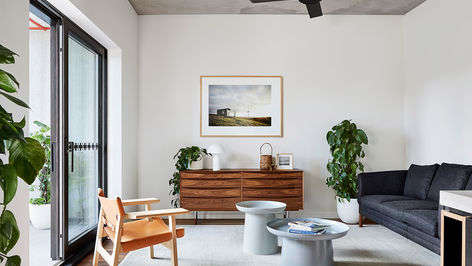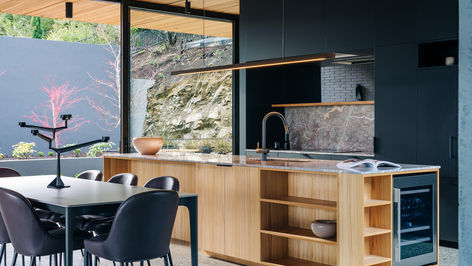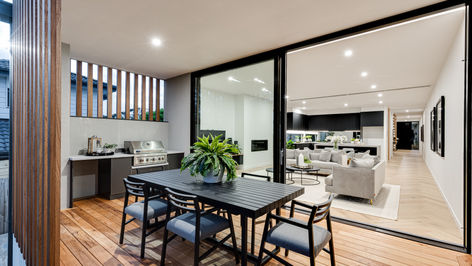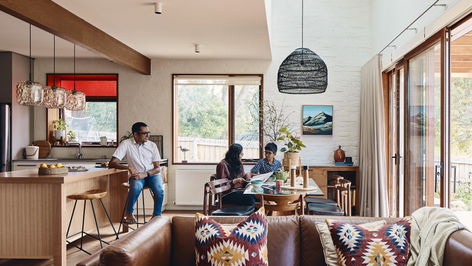Lift and Slide Door, Lift Slide Door, Timber Lift and Slide Door, Timber Lift Slide Door, Timber Lift Slide Door Melbourne, Lift Slide Door Melbourne, Performance Doors, High Performance Doors, German Doors.

lift and slide
-
BINQ Lift and Slide Doors are unrivalled in the Australian Market. Whether you're looking for large expanses of glass, high security, thermal performance, ease of use, or pure aesthetics, the Lift and Slide Door is the ultimate solution. It features bottom rolling heavy-duty Italian hardware to sustain weights up to 400kg, Australian-made double-glazed safety glass, a high-security multipoint locking system, and a unique Italian-made key made exclusive to BINQ, making it impossible to replicate.
Features
-
Italian Hardware
-
High Security Locking System
-
Secure Night Vent
-
Opening & Closing Brake
-
Double Gaskets
-
92mm x 68mm Timber Profiles
-
Up to 36mm Double Glazing or Triple Glazing
Size Restrictions
-
Up to 3m high
-
Up to 12m wide (Sliding)
-
Up to 18m wide (Stacking)
-
Larger custom sizes are available
Performance
-
uVal - as low as 1.2
-
SHGC - as low as .35
-
Up to 47dB of sound insulation
-
Up to BAL29 Compliant
Technical Designs
TIMBER species
-

Vic Ash
Bushfure Rating: BAL19
Properties
-
Density: 675-770kg/m3 at 12% moisture content; 1.3 to 1.5m3 of seasoned sawn timber per tonne.
-
Strength groups: S4 unseasoned, SD4 seasoned.
-
Stress grades: F7, F8, F11, F14 (unseasoned); F11, F14, F17, F22 (seasoned) when visually stress-graded according to AS 2082—2000: Timber—Hardwood—Visually stress-graded for structural purposes.
-
Joint groups: J3 unseasoned, JD3 seasoned.
-
Shrinkage to 12% MC: E. regnans—13.3% (tangential), 6.6% (radial); E. delegatensis—8.5% (tangential), 5.2% (radial); E. oblique—11.3% (tangential), 5.1% (radial).
-
Unit shrinkage: E. regnans—0.36% (tangential), 0.23% (radial); E. delegatensis—0.35% (tangential), 0.22% (radial). E. oblique—0.36% (tangential), 0.23% (radial). These values apply to timber reconditioned after seasoning.
-
Durability above-ground: Class 3.
-
Lyctine susceptibility: untreated sapwood of E. delegatensis and E. obliqua is susceptible to lyctid borer attack; untreated sapwood of E. regnans is not susceptible; normally marketed as a mix of the 3 species; therefore, classed as lyctid susceptible.
-
Termite resistance: not resistant.
-
Sustainability
-
100% is sourced from regrowth forests
-
100% is regrown.
-
Before harvesting, all flora, fauna, silvicultural, historical and cultural aspects are surveyed, plotted and allowed for. Source.
-
The harvesting process is scientifically designed to mimic natural growth pattern of Victorian Ash species to ensure regeneration occurs within an organic cycle. Source.
-
Less than 0.05% of the forest area is harvested each year on an 80 year rotation. (Yes, that decimal point is in the right place). It is then regenerated.
-
Only 6% of Victoria’s total forest area is both suitable and allocated for harvesting and regeneration on an 80 year cycle. These areas are scattered throughout the state to minimize and spread impact. Habitat trees are protected with protection zones varying in size depending on the animals requirements. 70% of the Victorian ash forests are in National Parks and reserves. Source.
-
The seed mix of each harvest is collected and re-planted in place of harvest to maintain diversity. Source.
-
100% of each log we receive is used. E.g. Off-cuts are finger jointed to make structural timber and sawdust used as a green energy solution to power our kilns. Source.
-
Up to 50% of the weight of kiln dried Victorian Ash is actually stored carbon (320kg per cubic metre approximately). This is far more helpful for life-cycle assessment and embodied energy considerations than other building materials or soft woods. Source.
-

Blackbutt
Bushfire Rating: BAL29
Properties
-
Air dry density: 930kg/m3 at 12% moisture content; about 1.1m3 of seasoned sawn timber per tonne.
-
Plantation-grown timber: age 4 years—64% mature timber density; age 11–17 years—80 to 88% mature timber density.
-
Strength groups: S2 unseasoned, SD2 seasoned.
-
Stress grades: F11, F14, F17, F22 (unseasoned), F17, F22, F27, F34 (seasoned) when visually stress-graded according to AS 2082—2000: Timber—Hardwood—Visually stress-graded for structural purposes.
-
Joint groups: J2 unseasoned; JD2 seasoned.
-
Shrinkage to 12% MC: 7.3% (tangential), 4.3% (radial).
-
Unit shrinkage: 0.37 % (tangential) 0.26 % (radial)—these values apply to timber reconditioned after seasoning.
-
Durability above-ground: Class 1 (life expectancy more than 40 years).
-
Lyctine susceptibility: sapwood is not susceptible to lyctine borer attack.
-
Termite resistance: resistant.
FINISHES
-
Our timber products are available in three different finishing options: pre-primed, painted, or stained. All of these options are formulated to create a barrier between the timber and Australia’s varying climate conditions.
It is always recommended that you apply one of these options to your products, as it will increase the lifespan of your doors and windows.
Our in-house finishing department uses world-standard procedures and equipment to maintain the timber’s structural integrity.
Finishing consists of a four-part process.
Prepping
Each unit is bogged, puttied and sanded to ensure that the finish is soft, smooth and consistent.
Priming
The unit is primed (base coat) by dipping it into a staining tray or pre-priming it using a spray gun. This penetrates the timber and treats it for rot and infestation. Then, the unit is hung to dry in a controlled-temperature environment, which generally takes 24 hours.
Re Prepping
Once the unit is dry, it is lightly sanded to ensure an even and consistent finish throughout.
Topcoat
It then progresses to the finishing line, where a spray gun applies a topcoat or paint approximately 400 microns thick (equivalent to three coats of paint). The unit is then placed in the drying room, which is again at a controlled temperature.
hardware
-
GLASS
-
Windows with standard glass provide little to no insulation properties and are the thermal weak point in buildings. In an average home, 40% of heat loss and 87% of heat gain is through inefficient glazing*.
An energy efficient window helps minimise the use of artificial heating and cooling, and makes the most of the natural climate resources. Insulglass IGU units are an essential component to minimise the need for artificial heating and cooling, reducing heat transfer by over 50%.
Utilising energy-efficient glass has many benefits:
-
Comfort levels: it will be naturally cooler in summer and warmer in winter, internal drafts and condensation are reduced
-
Energy savings: lowered cost for conditioning spaces with artificial heat and cooling
-
Less greenhouse emissions: with a lower load impact on artificial heating and cooling, there is less energy output and reduced emissions
-
Noise reduction: filters out significantly more noise than standard glass
For other glass options, please contact our design team.



























